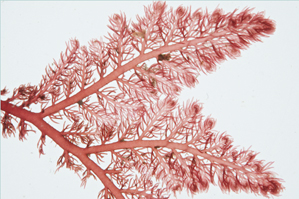Story behind the smelly red seaweed

 Perhaps you saw the news the other day in the Boston Globe about a nasty red seaweed washing up on the shores of Nahant, MA, where Northeastern’s Marine Science Center is located. The story quotes marine biology professor Matt Bracken, whose lab focuses on marine biodiversity.
Perhaps you saw the news the other day in the Boston Globe about a nasty red seaweed washing up on the shores of Nahant, MA, where Northeastern’s Marine Science Center is located. The story quotes marine biology professor Matt Bracken, whose lab focuses on marine biodiversity.
I spoke with Bracken this afternoon to find out the story behind the story. Turns out it’s actually long been in the making. Nearly two years ago, two Northeastern 3-Seas students, Christopher Marks and Natalie Low, were on a scientific research dive off the coast of Nahant when they ran into the unfamiliar red seaweed for the first time.
Their original mission had been to map biodiversity changes as they moved farther away from shore, but when they found this suspect organism, they knew it deserved its own attention. Both students had studied with Bracken before and knew the environment, and its species, well. This stuff was not from around here.
Bracken and his students exhausted their guides and scientific keys with zero luck — they found nothing native to the area, or even near the area, that remotely resembled the new species. Don Cheney, an assistant professor of biology and a seaweed specialist based at MSC, took one look at the stuff and advised Bracken’s group to get in touch with Trinity College professor Craig Schneider, who had his own red seaweed story to tell.
The previous summer, Schneider happened upon the unfamiliar red seaweed while enjoying his vacation on the beaches of Rhode Island. I didn’t yet mention that this stuff apparently smells like rotting eggs when it dries out…some vacation.
When Bracken and Schneider compared notes, and genetic tests, it turned out they were indeed looking at the same stuff: Heterosiphonia japonica*.
As it’s name implies, H. Japonica actually hails all the way from Japan, China and Korea — a rather difficult journey for a little seaweed plant, if you ask me. But this isn’t any old seaweed. H. japonica is prolific: break off a piece and it will easily grow into two new plants. “Other seaweeds can propagate vegetatively like this,” said Bracken, “but this grows twice as fast as other species around here.”
In the 1980s H. japonica turned up in Europe and Bracken believes the most likely transit of the stuff to this continent was from there via ship, as explained in the Globe article.
Invasive species that grow prolifically have a considerable advantage over native species…they can out-compete the other guys for resources and could potentially have a devastating impact on the biodiversity of the habitat. I asked Bracken why biodiversity is so important, and he equated it to a well-run municipality, which has doctors, teachers, trash collectors, and a bunch of other people each with specific role to help things run smoothly. It’s not that efficient to travel fifty miles to get to the doctor. Marine systems with lower biodiversity are also less efficient, said Bracken. Biodiversity is linked to higher rates of functioning, efficiency and productivity, he said.
“We’ve found that systems with fewer native seaweed species have lower biomass, are not as effective at using nutrients, and there’s less material coming in from the base of the food chain to support higher trophic levels,” he added.
While the presence of the red seaweed does correlate with lower biodiversity, they can’t yet say whether it’s causing the phenomenon. “There are two possibilities,” said Bracken. “Either the invasive species causes the decline, or it invades where diversity is already naturally low.”
Systems with lower diversity are less resilient against outside intruders because they aren’t as effective at occupying the available space throughout the seasons. If native diversity is high, invaders are less successful.
Just this week, Bracken’s team began setting up experiments to find out which came first: the biodiversity or h. japonica. They will systematically remove the invader from a finite bit of the shore. If they find that native species start to regrow, this will indicate that the invader’s presence is directly causing the low diversity. If the species don’t grow back, well…that would be another problem for another blog post.
If you’re on the coast, keep your eyes (and nose) out for the smelly red seaweed. While the health department reports that bacteria levels are normal in the areas where the seaweed shows up, it may not be such a good thing for the rest of the species around here. It currently extends from Northern Long Island Sound to Rockport, MA.
*I’m slightly overjoyed to have discovered the algaebase.





